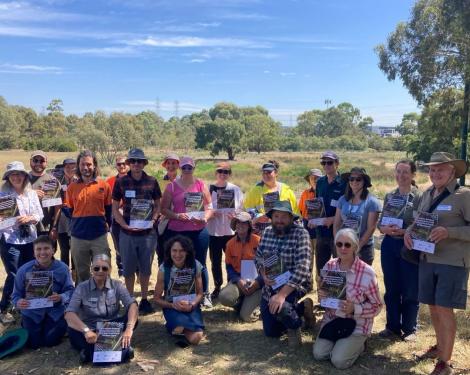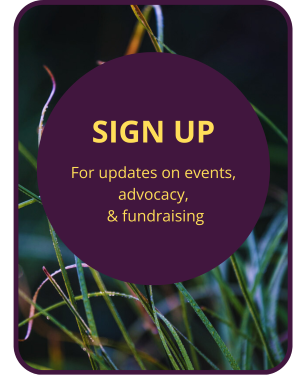On a beautiful sunny day in February during the biderap season, a group of land managers, scientists and community supporters gathered by wetlands in Fawkner’s Moomba Park to celebrate the launch of a new strategy for the Growling Grass Frog, a species that once thrived along the Merri Creek but now faces serious threats.
The strategy envisions a future where the frog is regularly heard and seen throughout the Merri Creek and its tributaries from Somerton to Fawkner, supported by collaboration between land and water managers, scientists, Traditional Owners, and local communities.
 MCMC launch of the Strategy - 'Securing the Southern Metapopulations of the Growling Grass Frog in the Merri Creek.' Photograph by MCMC's Bernadette Thomas.
MCMC launch of the Strategy - 'Securing the Southern Metapopulations of the Growling Grass Frog in the Merri Creek.' Photograph by MCMC's Bernadette Thomas.
Yasmin Kelsall, Environmental Planning Lead with Merri Creek Management Committee (MCMC), explains the urgency of the strategy: “The southernmost populations of Growling Grass Frog in the Merri Creek exist in a precarious state, threatened by an intensification in private land development, particularly within the last 20 years. These beautiful frogs are also threatened by the devastating chytrid fungus, as well as the effects of new developments upstream within Melbourne's northern growth corridor.”
Historically, Growling Grass Frogs flourished in natural wetland environments along the creek, but changes in urbanisation and stormwater runoff have made the waterway a less stable habitat.
“Stormwater really flushes through in great volumes,” Yasmin explains. “It washes away vegetation that the frogs like to use, and in breeding season, it can wash away the eggs.” As a result, the frogs increasingly seek refuge in off-stream locations, such as quarry holes. Interestingly, these environments – while far from pristine – offer warm, saline groundwater that can help the frogs fight off chytrid fungus. “It's been a really interesting project looking at habitat through a different lens,” says Yasmin. “The area covered by the strategy presents challenges but also offers unique opportunities.”
The strategy’s ambitious goals include increasing the number of sites occupied by Growling Grass Frogs by 20% within the next decade and expanding off-stream wetland areas by the same margin. Importantly, it aims to ensure that no breeding populations identified in 2024 are lost.
This vision has been bolstered by community support. A 2024 fundraising campaign allowed Merri Creek Management Committee (MCMC) to begin monitoring frog populations at four sites, including three new locations. Initial results from November 2024 were promising: Growling Grass Frog activity was detected in locations along and adjacent to the Merri Creek in Campbellfield, Somerton and Epping and in Fawkner. In one location, more than 30 adult frogs were observed – many foraging in areas that have seen habitat improvement works. The final round of monitoring, completed recently, has determined in almost all locations, that breeding was successful.
Habitat restoration efforts are already underway. Weed control began last spring and will continue in the coming weeks, with Merri-bek Council’s First Nations Working Group and Friends of Merri Creek volunteers set to assist with revegetation efforts in late winter. These efforts are vital to creating and maintaining the wetlands needed for the frogs to thrive.
Community engagement remains a central pillar of the strategy’s success. One of the recent MCMC events, a torchlit ‘After Dark with Growling Grass Frogs’ tour, gave volunteers and local residents a chance to see the frogs up close. Adalita Srsen, a participant in the tour, shared her excitement: “Seeing the frogs in the wild was such a thrill and privilege. They’re truly incredible creatures. I appreciate the passion, dedication, and everything MCMC does for the frogs and the beautiful natural wonderland right on our doorstep.”
With strong scientific backing, community engagement, and on-the-ground conservation efforts, this strategy represents a hopeful step forward for the Growling Grass Frog. As Yasmin puts it, “It’s just so good to be empowered to learn more about what’s happening with our local frog populations; it allows us to make better decisions.”





 Merri Creek Management Committee. 2 Lee St, East Brunswick, Victoria, Australia 3057
Merri Creek Management Committee. 2 Lee St, East Brunswick, Victoria, Australia 3057